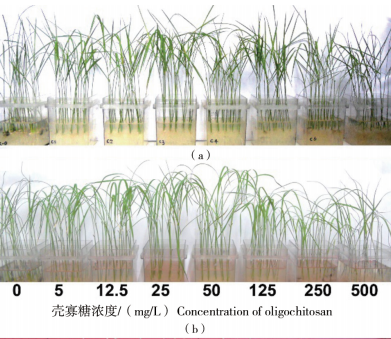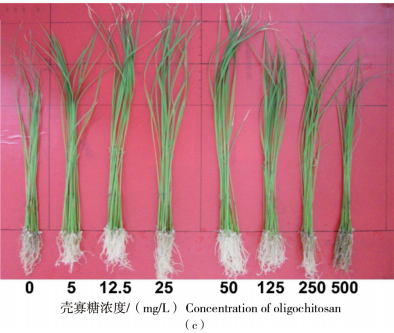Effects of Chitosan oligosaccharide on the Growth and Stress Resistance of Rice Seedlings
Release:2021.06.02Chitosan oligosaccharide has good water solubility and strong biological activity, and is a new type of plant growth regulator. Chitosan oligosaccharide can be used as immune activation factors to induce plant innate immunity, synthesize antibacterial substances, stimulate plant gene defense, and enhance plant disease resistance. Studies have shown that oligo chitosan can play a positive role when plants encounter adversity, increase the net photosynthesis rate, resist the synthesis of osmotic substances, increase the antioxidant enzyme activity of plants, enhance the ability to scavenge free radicals, protect the membrane system, and strengthen the plant. The self-resistance promotes plant growth. The School of Life Sciences, Hubei Normal University took rice seedlings as the research object, and studied the effects of Chitosan oligosaccharide on the growth and resistance of rice seedlings under low temperature, drought and salt stress. The seedlings are divided into 9 groups, the normal growth condition control group (CK) and 8 stress groups. The low temperature, drought and salt stress groups use 0.5, 12.5, 25, 50, 125, 250 and 500 mg/L Chitosan oligosaccharide solution respectively. After spraying on the leaf surface and the back of the leaf, the leaf fully absorbs the solution (2~3h) and then undergoes stress treatment respectively.


Comparison of plant growth under low temperature stress (a) End of stress; (b) and (c) Growth recovery for 72 h The results show that: 25 and 50 mg/L treatment groups can reduce the damage of low temperature to rice; 12.5, 25, 50 and 125 mg/L treatment groups can reduce drought stress damage to rice leaves, and 25 and 50 mg/L concentrations can alleviate salt The adverse effects of stress on rice growth. In summary, the treatment with a suitable concentration of Chitosan oligosaccharide can reduce the damage of rice seedlings caused by low temperature, drought and high salinity, and especially has a better effect in improving crop resistance to low temperature.



